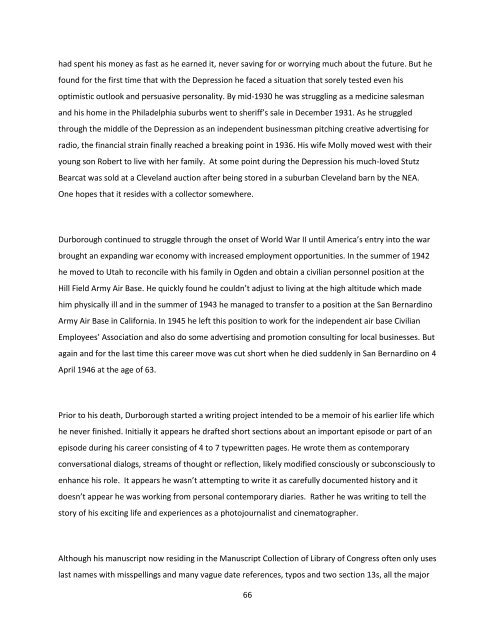"On the Firing Line with the Germans" Film Annotations (2017)
Film annotations, describing the making of Wilbur H. Durborough's World War I feature film "On the Firing Line with the Germans (USA, 1915) by authors Cooper C. Graham, Ron van Dopperen and James W. Castellan (April 2017). For more information visit our weblog http://shootingthegreatwar.blogspot.nl The movie can be watched on our YouTube channel: https://youtu.be/958QR_Cdg5U
Film annotations, describing the making of Wilbur H. Durborough's World War I feature film "On the Firing Line with the Germans (USA, 1915) by authors Cooper C. Graham, Ron van Dopperen and James W. Castellan (April 2017).
For more information visit our weblog http://shootingthegreatwar.blogspot.nl
The movie can be watched on our YouTube channel:
https://youtu.be/958QR_Cdg5U
Create successful ePaper yourself
Turn your PDF publications into a flip-book with our unique Google optimized e-Paper software.
had spent his money as fast as he earned it, never saving for or worrying much about <strong>the</strong> future. But he<br />
found for <strong>the</strong> first time that <strong>with</strong> <strong>the</strong> Depression he faced a situation that sorely tested even his<br />
optimistic outlook and persuasive personality. By mid-1930 he was struggling as a medicine salesman<br />
and his home in <strong>the</strong> Philadelphia suburbs went to sheriff’s sale in December 1931. As he struggled<br />
through <strong>the</strong> middle of <strong>the</strong> Depression as an independent businessman pitching creative advertising for<br />
radio, <strong>the</strong> financial strain finally reached a breaking point in 1936. His wife Molly moved west <strong>with</strong> <strong>the</strong>ir<br />
young son Robert to live <strong>with</strong> her family. At some point during <strong>the</strong> Depression his much-loved Stutz<br />
Bearcat was sold at a Cleveland auction after being stored in a suburban Cleveland barn by <strong>the</strong> NEA.<br />
<strong>On</strong>e hopes that it resides <strong>with</strong> a collector somewhere.<br />
Durborough continued to struggle through <strong>the</strong> onset of World War II until America’s entry into <strong>the</strong> war<br />
brought an expanding war economy <strong>with</strong> increased employment opportunities. In <strong>the</strong> summer of 1942<br />
he moved to Utah to reconcile <strong>with</strong> his family in Ogden and obtain a civilian personnel position at <strong>the</strong><br />
Hill Field Army Air Base. He quickly found he couldn’t adjust to living at <strong>the</strong> high altitude which made<br />
him physically ill and in <strong>the</strong> summer of 1943 he managed to transfer to a position at <strong>the</strong> San Bernardino<br />
Army Air Base in California. In 1945 he left this position to work for <strong>the</strong> independent air base Civilian<br />
Employees’ Association and also do some advertising and promotion consulting for local businesses. But<br />
again and for <strong>the</strong> last time this career move was cut short when he died suddenly in San Bernardino on 4<br />
April 1946 at <strong>the</strong> age of 63.<br />
Prior to his death, Durborough started a writing project intended to be a memoir of his earlier life which<br />
he never finished. Initially it appears he drafted short sections about an important episode or part of an<br />
episode during his career consisting of 4 to 7 typewritten pages. He wrote <strong>the</strong>m as contemporary<br />
conversational dialogs, streams of thought or reflection, likely modified consciously or subconsciously to<br />
enhance his role. It appears he wasn’t attempting to write it as carefully documented history and it<br />
doesn’t appear he was working from personal contemporary diaries. Ra<strong>the</strong>r he was writing to tell <strong>the</strong><br />
story of his exciting life and experiences as a photojournalist and cinematographer.<br />
Although his manuscript now residing in <strong>the</strong> Manuscript Collection of Library of Congress often only uses<br />
last names <strong>with</strong> misspellings and many vague date references, typos and two section 13s, all <strong>the</strong> major<br />
66



